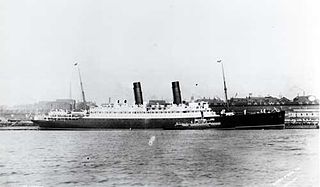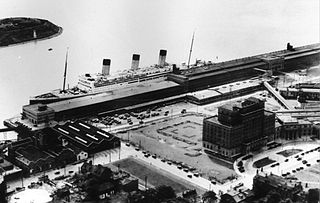
RMS Laconia was a Cunard ocean liner built by Swan Hunter & Wigham Richardson, launched on 27 July 1911, with the wife of the U.S. Ambassador Mrs. Whitelaw Reid christening the vessel. Laconia was delivered to the Cunard Line on 12 December 1911, and began service on 20 January 1912. She was the first Cunard ship of that name. She was torpedoed and sunk on 25 February 1917 during World War I; 12 passengers were killed.

Steerage is a term for the lowest category of passenger accommodation in a ship. In the nineteenth and early twentieth century, considerable numbers of persons travelled from their homeland to seek a new life elsewhere, in many cases North America and Australia. Many of those people were destitute in their homeland and had the minimum of resources to procure transportation. The term later widened to imply the lowest category of accommodation on a passenger vessel.

Pier 21 is a former ocean liner terminal and immigration shed from 1928 to 1971 in Halifax, Nova Scotia, Canada. Nearly one million immigrants came to Canada through Pier 21, and it is the last surviving seaport immigration facility in Canada. The facility is often compared to the landmark American immigration gateway Ellis Island. The former immigration facility is now occupied by the Canadian Museum of Immigration, the Nova Scotia College of Art and Design as well as various retail and studio tenants.

SS Kaiser Wilhelm II was a Norddeutscher Lloyd (NDL) Kaiser-class ocean liner. She was launched in 1902 in Stettin, Germany. In the First World War she was laid up in New York from 1914 until 1917, when the US Government seized her and renamed her USS Agamemnon. In 1919 she was decommissioned from the Navy and laid up. In 1927 she was transferred to the United States Army, who renamed her USAT Monticello. She was scrapped in 1940.
Economy class, also called third class, coach class, steerage, or to distinguish it from the slightly more expensive premium economy class, standard economy class or budget economy class, is the lowest travel class of seating in air travel, rail travel, and sometimes ferry or maritime travel. Historically, this travel class has been called tourist class or third class on ocean liners.
Norddeutscher Lloyd was a German shipping company. It was founded by Hermann Henrich Meier and Eduard Crüsemann in Bremen on 20 February 1857. It developed into one of the most important German shipping companies of the late 19th and early 20th centuries, and was instrumental in the economic development of Bremen and Bremerhaven. On 1 September 1970, the company merged with Hamburg America Line (HAPAG) to form Hapag-Lloyd AG.

SS City of Glasgow of 1850 was a single-screw iron hulled passenger steamship of the Inman Line. Based on ideas pioneered by Isambard Kingdom Brunel's SS Great Britain of 1845, City of Glasgow established that Atlantic steamships could be operated profitably without government subsidy. After a refit in 1852, she was also the first Atlantic steamship to carry steerage passengers, representing a significant improvement in the conditions experienced by immigrants. In March 1854 City of Glasgow vanished while enroute from Liverpool to Philadelphia with 480 passengers and crew aboard.

The Inman Line was one of the three largest 19th-century British passenger shipping companies on the North Atlantic, along with the White Star Line and Cunard Line. Founded in 1850, it was absorbed in 1893 into American Line. The firm's formal name for much of its history was the Liverpool, Philadelphia and New York Steamship Company, but it was also variously known as the Liverpool and Philadelphia Steamship Company, as Inman Steamship Company, Limited, and, in the last few years before absorption, as the Inman and International Steamship Company.

The Allan Shipping Line was started in 1819, by Captain Alexander Allan of Saltcoats, Ayrshire, trading and transporting between Scotland and Montreal, a route which quickly became synonymous with the Allan Line. By the 1830s the company had offices in Glasgow, Liverpool and Montreal. All five of Captain Allan's sons were actively involved with the business, but it was his second son, Sir Hugh Allan, who spearheaded the second generation. In 1854, Hugh launched the Montreal Ocean Steamship Company as part of the Allan Line, and two years later ousted Samuel Cunard to take control of the Royal Mail contract between Britain and North America. By the 1880s, the Allan Line was the world's largest privately owned shipping concern.

SS Abyssinia was a British mail liner built in 1870, and originally operated by the Cunard Line on the Liverpool–New York route. She later served the Guion Line on the same route and the Canadian Pacific Line in the Pacific. In December 1891, Abyssinia was destroyed mid-Atlantic without loss of life by a fire that started in her cargo of cotton, highlighting the danger in carrying both cotton and passengers on the same ship.

The New England Historic Genealogical Society (NEHGS) is the oldest and largest genealogical society in the United States, founded in year 1845.
The Liverpool and Great Western Steamship Company, known commonly as the Guion Line, was a British passenger service that operated the Liverpool-Queenstown-New York route from 1866 to 1894. While incorporated in Great Britain, 52% of the company's capital was from the American firm, Williams and Guion of New York. Known primarily for transporting immigrants, in 1879 the line started commissioning Blue Riband record breakers to compete against Cunard, White Star and Inman for first class passengers. The financial troubles of one of the company's major partners in 1884 forced the firm to return its latest record breaker, the Oregon, to her builders and focus again on the immigrant trade. The company suspended sailings in 1894 because of new American restrictions on immigrant traffic.

William Williams was the federal commissioner of immigration for the Port of New York, from 1902 to 1905 and again, from 1909 to 1914. His office was on Ellis Island, which was the location of the nation's most important immigrant inspection station.

The Fabre Line or Compagnie Française de Navigation à Vapeur Cyprien Fabre & Compagnie was a French shipping line formed in 1881 by Cyprien Fabre. It began operating a small fleet of sailing ships in 1865. Its ports of call included New York, NY; Providence, RI; Boston, MA; Ponta Delgada, Madeira, and Lisbon, Portugal; Piraeus and Salonica, Greece; Algiers, Algeria; Beirut, Lebanon; Naples and Palermo, Italy; Alexandria, Egypt; Jaffa and Haifa, Palestine; Constantinople, Turkey; Monaco; and Marseilles, France.

The SS City of Chester was a steamship built in 1875 that sank after a collision in a dense fog with SS Oceanic at the Golden Gate in San Francisco Bay on August 22, 1888. She was owned by the Oregon Railroad Co. and leased by the Pacific Coast Steamship Company.

The Canadian Museum of Immigration at Pier 21, in Halifax, Nova Scotia, is Canada's national museum of immigration. The museum occupies part of Pier 21, the former ocean liner terminal and immigration shed from 1928 to 1971. Pier 21 is Canada's last remaining ocean immigration shed. The facility is often compared to Ellis Island (1892–1954), in terms of its importance to mid-20th-century immigration to Canada an association it shares with 19th century immigration history at Grosse Isle, Quebec (1832–1932) and Partridge Island in Saint John, New Brunswick (1785–1941). The museum began as an independent institution run by the Pier 21 Society in 1999. It became a national museum run by the Canadian federal government in 2011.

The Steerage Act of 1819, also called the Manifest of Immigrants Act, was an Act passed by the United States federal government on March 2, 1819, effective January 1, 1820. Its full name is An Act regulating passenger ships and vessels. It was the first law in the United States regulating the conditions of transportation used by people arriving and departing by sea. In addition to regulating conditions in ships, the act also required ship captains to deliver and report a list of passengers with their demographic information to the district collector. The Act was passed near the end of the term of the fifteenth United States Congress and signed into law by then United States President James Monroe. The Act was augmented by many additional Acts starting 1847 and finally repealed and superseded by the Carriage of Passengers Act of 1855. At the time of passage of the Act, the United States had no laws restricting immigration. In fact, the first federal legislation regulating immigration, the Page Act of 1875, was over 50 years in the future.

The Carriage of Passengers Act of 1855 was an act passed by the United States federal government on March 3, 1855, replacing the previous Steerage Act of 1819 and a number of acts passed between 1847 and 1849 with new regulations on the conditions of sea transportation used by passenger ships landing in the United States. The law was passed by the 33rd United States Congress and signed into law by President Franklin Pierce.

SS Tenyo Maru was a Japanese ocean-going passenger liner of the Toyo Kisen Kabushiki Kaisha completed in 1908 by the Mitsubishi Dockyard & Engine Works, Nagasaki, Japan. Its sister ships were SS Chiyo Maru and SS Shinyō Maru (1911). It had accommodation for 275 first-class, 54 second-class, and 800 steerage passengers, and could carry over 8,000 tons of cargo. The steerage class had an opium den for Chinese passengers. The ship had the following dimensions: length overall 575 ft., between perpendiculars 558 ft., breadth 63 ft., depth to shelter deck 46 ft. 6 in., to upper deck 38 ft. 6 in., gross tonnage 14,700 tons; displacement 21,500 tons at 31 ft. 8 in. draught.

SS Moltke was a German ocean liner built by Blohm & Voss for the Hamburg America Line. She was named after Helmuth von Moltke. Sister ship to the SS Blücher, she was launched in 1901, and sailed her maiden voyage in February the following year. According to the New Haven Morning Journal and Courier, she "was built for the eastern service of the line, but on nearing completion her interior arrangements were adapted to the New York service at Hamburg." Her first commanding officer was Captain Christian Dempwolf.
















